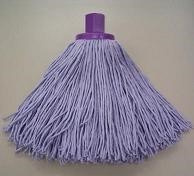The Spanish Supreme Court recently had to consider the likelihood of confusion between the representation of a lila mop registered as a two-dimensional trade mark and another party’s actual product, again, a lila mop. The signs at issue were the following:
| Trademarks owned by the plaintiff | Defendant’s use |

|
 |
The Court rejected the claim of infringement. Disregarding the fact that the earlier mark was indeed meant to protect the shape of the mop itself, and taking it instead as a purely figurative mark or a logo, the Court could only conclude the absence of likelihood of confusion.
According to ECJ case law, the criteria laid down for assessing the distinctiveness of 3D trademarks consisting of the appearance of the product itself apply also to figurative marks consisting of a 2D representation of the product. Neither is independent of the appearance of the product and the relevant public does not perceive those signs as an indication of commercial origin absent exceptional circumstances.
The Spanish Supreme Court, in its judgment of 25 February 2016, applied these same criteria to the infringement action before it. In the case before the Court, the owner of a Spanish and a Community (soon: European Union) trademark consisting of a 2D representation of a lila mop, brought infringement proceedings against a competitor who was also selling lila mops, as shown above.
The action was rejected in its entirety. The Court found that the plaintiff was trying to enhance the scope of protection of its 2D trademarks to cover the shape of the mop. In fact, the plaintiff claimed that the lila mop commercialized by the defendant was confusingly similar to the lila mop that the plaintiff was manufacturing and selling and which he had protected by way of its 2D trademarks.
The Court considered that the assessment of trademark infringement required the comparison between the figurative trademarks as registered —that is, the 2D representation of a mop (not the shape of the mop itself) and the shape of the mops themselves as marketed by the defendant.
In assessing the scope of protection of the earlier marks, the Court concluded that the owner of a figurative trademark that consists of the reproduction of the product it designates, cannot enjoy a monopoly to such products in the market, especially when, as was the case here, the shape represented by the alleged infringing trademark was the commonly used shape for this type of product.
It should be noted that the Spanish Supreme Court in no way questioned the validity of the earlier marks. However, it severely curtailed their protection by limiting them to the specific two-dimensional representation of which they consisted.
In the absence of evidence of acquired distinctiveness of the shape of the product, or of a shape or appearance that departs significantly from the norm for the type of product at issue, this outcome seems correct. It is in line with the case law of the Court of Justice and avoids a serious misbalance between what can be achieved with a two-dimensional as opposed to a three-dimensional registration of the shape of a product.
_____________________________
To make sure you do not miss out on regular updates from the Kluwer Trademark Blog, please subscribe here.
Kluwer IP Law
The 2022 Future Ready Lawyer survey showed that 79% of lawyers think that the importance of legal technology will increase for next year. With Kluwer IP Law you can navigate the increasingly global practice of IP law with specialized, local and cross-border information and tools from every preferred location. Are you, as an IP professional, ready for the future?
Learn how Kluwer IP Law can support you.


